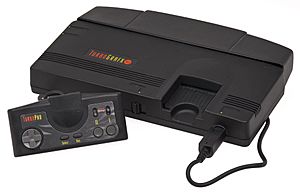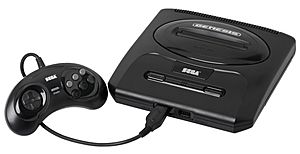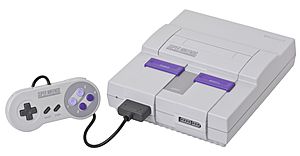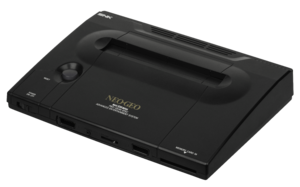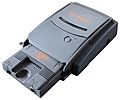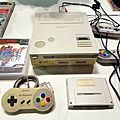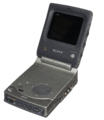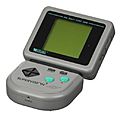Fourth generation of video game consoles facts for kids
The fourth generation of video game consoles, often called the 16-bit era, was a big time for video games. It started on October 30, 1987, when NEC Home Electronics released its PC Engine in Japan. In North America, it was known as the TurboGrafx-16.
Even though NEC launched the first console, two companies really took over the market: Sega with its Sega Mega Drive (called Sega Genesis in North America) and Nintendo with its Super Nintendo Entertainment System (SNES). This era also saw many popular handheld game consoles that used cartridges, like the Nintendo Game Boy (1989), Atari Lynx (1989), Sega Game Gear (1990), and TurboExpress (1990).
Nintendo, which was very successful in the previous generation, continued to lead in sales worldwide. But Sega also did incredibly well. They even created a new famous character, Sonic the Hedgehog, to compete with Nintendo's Super Mario series of games. Other companies tried to release consoles, but they weren't as popular.
Most games still came on ROM cartridges. However, the first systems that used optical disks, like the Philips CD-i, also appeared, but they didn't sell much. As games became more detailed, people started worrying about violence in games, especially titles like Mortal Kombat and Night Trap. This led to the creation of the Entertainment Software Rating Board (ESRB), which gives age ratings to games.
The fourth generation consoles stayed popular even after the fifth generation video game consoles started appearing around 1994. But by 1996, sales of these older consoles and their games dropped a lot. This generation officially ended in 2004 when the Neo Geo stopped being made.
Contents
What Made These Consoles Different?
Fourth generation consoles were a big step up from older ones. Here are some key improvements:
- They used more powerful 16-bit microprocessors.
- Game controllers had many more buttons (from 3 to 8).
- Games used Parallax scrolling, which made backgrounds look like they were moving at different speeds, creating a cool sense of depth.
- Characters and objects (called sprites) could be much larger and more detailed.
- Games had many more colors on screen, from a huge range of choices.
- Sound became much better, with stereo audio and digital audio playback.
- Music in games became more advanced, sounding richer and more complex.
Some special features also appeared:
- Backgrounds could look pseudo-3D, with effects like scaling and rotation.
- Individual sprites could also be scaled (made bigger or smaller) and rotated.
- Some games even had simple flat-shaded 3D polygon graphics.
- Some systems supported Surround sound.
- CD-ROM add-ons allowed for much larger games and even full motion video (like short movie clips).
Home Consoles of the Era
TurboGrafx-16
The PC Engine was made by Hudson Soft and NEC. It came out in Japan in October 1987 and in North America as the TurboGrafx-16 in August 1988.
At first, the PC Engine did very well in Japan, partly because it could use games on the new CD-ROM format. NEC even released a CD add-on in 1990 and later a combined system called the TurboDuo.
In the United States, the TurboGrafx-16 didn't keep its strong sales. NEC stopped making the TurboGrafx-16 and Turbo Duo in North America by 1994.
Mega Drive/Genesis
The Mega Drive was released in Japan in October 1988. It came to New York City and Los Angeles in August 1989 as the Sega Genesis, and later to the rest of North America. It launched in Europe and Australia in November 1990 with its original name.
Sega used their new mascot, Sonic the Hedgehog, to promote the Genesis. They advertised it as the "cooler" console compared to Nintendo's. Their ads often directly challenged Nintendo.
When the popular arcade game Mortal Kombat was released for home consoles, Nintendo decided to remove the game's blood and gore. Sega, however, kept the intense content in their version, though players had to enter a secret code to see it. Sega's Mortal Kombat sold much better than Nintendo's. This led to discussions in the U.S. government about video game violence and the creation of the Entertainment Software Rating Board (ESRB) to rate games. Sega later decided that keeping the gore wasn't worth the trouble. For Mortal Kombat II, Nintendo allowed the game to be less censored.
The Genesis wasn't very popular in Japan, but it sold 40 million units worldwide. By late 1995, Sega was making too many different consoles and add-ons. They decided to stop making the Mega Drive in Japan to focus on their new Sega Saturn. This was a problem in North America, where many people still wanted Genesis games.
Super NES
Nintendo didn't want to design a new system at first. But as other companies released more powerful consoles, Nintendo saw their lead shrinking. So, they released their fourth-generation console, the Super Famicom, in Japan in November 1990. All 300,000 units sold out in just a few hours! It came to North America as the Super Nintendo Entertainment System (SNES) in August 1991.
Even with strong competition from the Mega Drive/Genesis, the Super NES eventually became the best-selling console of this generation, selling 49.10 million units worldwide. It stayed popular even into the next generation of consoles. Nintendo's console was known for its amazing graphics and sound, and for exclusive games like F-Zero, Starfox, Donkey Kong Country, Super Mario Kart, Super Mario World, The Legend of Zelda: A Link to the Past, and Super Metroid.
Compact Disc Interactive (CD-i)
The CD-i was announced in the late 1980s, and the first machines came out in 1991. Philips, the company that made it, said it was more than just a game machine; it could be used for many things, like watching videos. Philips even had the right to use some of Nintendo's famous characters in their games. However, the CD-i was a big failure and only sold about 1 million units worldwide before it was stopped in 1998.
Neo Geo
Released by SNK in 1990, the Neo Geo was a home version of a popular arcade system. It had much better graphics and sound than other home consoles. But it was extremely expensive, costing $649.99 at launch, and games often cost over $250! This made the console only affordable for a small group of people.
Add-ons
Nintendo, NEC, and Sega also made extra devices for their consoles. NEC was first with the TurboGrafx CD system in 1990. It cost $399.99 and wasn't very popular in North America, but it helped the PC Engine succeed in Japan. The Sega CD was also expensive ($300) and didn't have many games at first. Sega also had a unique service called Sega Channel, where you could subscribe to play games through your TV cable line.
Nintendo also tried add-ons like the Satellaview, a satellite service only in Japan, and the Super Game Boy, which let you play Game Boy games on your TV in color.
Worldwide Sales Standings
Here's how the main home consoles sold worldwide:
| Console | Company | Units sold |
|---|---|---|
| Super Nintendo Entertainment System | Nintendo | 49.1 million |
| Sega Mega Drive/Genesis | Sega | 35.25 million |
| PC Engine/TurboGrafx-16 | NEC | 10 million |
| Sega CD | Sega | 2.765 million |
| PC Engine CD-ROM² | NEC | 1.92 million |
| Neo Geo AES | SNK | 1.18 million |
| Philips CD-i | Philips | 1 million |
| Sega 32X | Sega | 800,000 |
| Neo Geo CD | SNK | 570,000 |
Handheld Systems
The first handheld game console of this generation was the Game Boy, released on April 21, 1989. It became incredibly popular and sold way more than any other handheld. This was surprising because it had an older 8-bit processor and a simple black-and-white screen, while its competitors had color screens. Three huge game series started on the Game Boy: Tetris (which came with the Game Boy), Pokémon, and Kirby. The Game Boy, with some updates, was made until 2008, lasting over 18 years!
The Atari Lynx had cool features like color graphics, a backlight, and could link up to sixteen units for multiplayer games. But it had a very short battery life (about 4.5 hours), was expensive, and didn't have many popular games. Because of this, it sold less than 500,000 units.
The Game Gear was the third main handheld. It had graphics similar to the Master System and could even play Master System games with an adapter. You could also turn it into a portable TV! However, it was bulky, had poor battery life (a little better than the Lynx), and came out later than the Game Boy. Even though it sold more than twenty times as many units as the Lynx, it couldn't beat the Game Boy. Sega stopped making the Game Gear in 1997.
Other handhelds included the TurboExpress, a portable version of the TurboGrafx-16 released by NEC in 1990. It also had a color screen and could use the same game cards as the TurboGrafx-16. But its battery life was even worse than the Lynx and Game Gear, lasting only about three hours. It sold 1.5 million units. The Game Boy Pocket was a smaller, improved Game Boy released in 1996.
List of Handheld Consoles
| Console | Game Boy / Game Boy Pocket / Game Boy Light | Atari Lynx | Game Gear | TurboExpress |
|---|---|---|---|---|
| Manufacturer | Nintendo | Atari | Sega | NEC |
| Image | 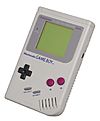 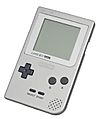 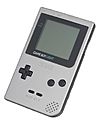 |
 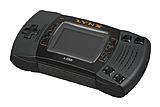 |
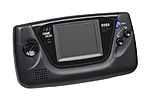 |
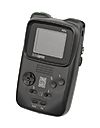 |
| Launch price |
|
US$189.99 |
|
US$299.99 |
| Release date |
|
|
|
|
| Units sold | 118.69 million (including Game Boy Color) | 500,000 | 11 million | 1.5 million |
| Media | Cartridge | Cartridge | Cartridge | Datacard |
| Best-selling games |
|
RoadBlasters | Sonic the Hedgehog 2 | Bonk's Adventure |
| Backward compatibility | N/A (Original cartridges compatible with later models) | N/A | Master System (using Cartridge Adapter) | TurboGrafx-16 (HuCard only) |
Software: Important Games of the Era
This generation saw many amazing games that are still loved today:
- Chrono Trigger (SNES) by Square is often called one of the greatest video games of all time.
- Donkey Kong Country (SNES) by Rare and Nintendo had incredible graphics that helped Nintendo win the console war. It became a huge seller.
- FIFA International Soccer (Genesis, SNES) by Extended Play Productions and EA Sports was a very important sports game.
- Gunstar Heroes (Genesis) by Treasure and Sega is known as one of the best action games of its time.
- John Madden Football (1990) (Genesis, SNES) by Park Place Productions and EA Sports helped the Genesis console and Electronic Arts become successful early on.
- Super Metroid (SNES) by Nintendo Research & Development 1 and Nintendo is still seen by many as one of the "best games of all time."
- Mortal Kombat (Arcade, Genesis, SNES) by Midway Games caused a lot of discussion because of its violent themes. The uncensored Genesis version sold much better than the SNES version. This led to government hearings and the creation of the Entertainment Software Rating Board (ESRB).
- NHLPA Hockey '93 (Genesis, SNES) by Park Place Productions and EA Sports is considered one of the best sports games ever made.
- Phantasy Star II (Genesis) by Sega Consumer Development Division 2 and Sega is known as one of the best and most important role-playing games (RPGs) for consoles.
- Secret of Mana (SNES) by Square brought the Seiken Densetsu series to Europe and North America.
- Sonic the Hedgehog (Genesis) by Sonic Team and Sega was Sega's big attempt to compete with Nintendo's Mario. It was key to the Genesis's success and started a very popular game series.
- Street Fighter II (Arcade, Genesis, SNES) by Capcom created a huge fanbase and set many trends for fighting games today, like having many colorful fighters from different countries. It's Capcom's best-selling consumer game ever.
- Streets of Rage 2 (Genesis) by Sega AM7 and Sega is thought to be the best "beat 'em up" game of the generation.
- Super Mario World 2: Yoshi's Island (SNES) by Nintendo Entertainment Analysis & Development (Nintendo EAD) and Nintendo is often called one of the best 2D platformer games.
- The Legend of Zelda: A Link to the Past (SNES) by Nintendo EAD and Nintendo was even more popular than the previous Zelda games. It went back to the top-down adventure style of the first Zelda game.
- Ys Book I & II (TurboGrafx) by Nihon Falcom was one of the first video games widely released on CD-ROM in 1989 (Japan) and 1990 (North America). It was praised for its story and gameplay, and it was a pioneer in using voice acting, animated scenes, and pre-recorded music, which later became common in games.
Images for kids
-
PC Engine CoreGrafx II with Super CD-ROM2
-
Wondermega by Victor
-
Sega Genesis CDX, a combination Sega Genesis and Sega CD
-
Neo Geo CD by SNK
-
CD-i Intelligent Discman IVO
See also
 In Spanish: Videoconsolas de cuarta generación para niños
In Spanish: Videoconsolas de cuarta generación para niños
- 1980s in video games
- 1990s in video games
- Capcom Power System Changer
- Konix Multisystem


